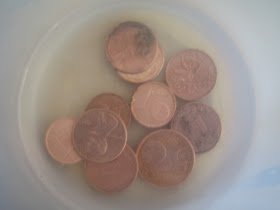Experimenting with Copper Pennies
After our penny cleaning and penny polishing activities, our second penny experiment came from about.com.
Following the instructions of Chemistry Fun with Pennies we did the following:
Materials needed:
10 Pennies (We used a medley of pennies, namely the US 1 cent, Canadian 1 cent and the Euro 1 cent.)
1/4 cup white vinegar (dilute acetic acid)
1 teaspoon salt (NaCl)
1 shallow, clear glass or plastic bowl (not metal)
1-2 clean steel screws or nails
water
STEP 1: Soak the pennies in a Vinegar and Salt solution for half an hour.
STEP 2: Take out half of the pennies, rinse them and leave on an absorbent paper. Take the other half of the pennies and leave them on an absorbent paper without rinsing them. Mark the coins and leave them for an hour
STEP 3: DONOT throw away the salt and vinegar and place 2-3 nails and screw in the solution. Try and place one half dipped in the solution and the next half out of it. Leave it for a half to 1 hour. We left ours for an hour till all the reaction stopped.
OBSERVATION: withing a few moments the reaction becomes visible as tiny bubble appear on the surface of the screws and nails, as visible in the above picture.
Half an Hour Later
We noticed something very fascinating Subhanallah!
Click on the below images and see the enlarged image. You can clearly see the bubbles rising up in a straight line from the screws.
SUBHANALLAH
We also noticed that the nails and screws in the solution had become slightly discolored.
An Hour Later
All reaction had stopped completely, and this is how the nail and screws looked.
The half dipped screw.
All the screws and nail.
WHAT HAPPENED ?
"
The copper that coats the nail/screw comes from the pennies. However, it exists in the salt/vinegar solution as positively charged copper ions as opposed to neutral copper metal. Nails and screws are made of steel, an alloy primarily composed of iron. The salt/vinegar solution dissolves some of the iron and its oxides on the surface of the nail, leaving a negative charge on the surface of the nail. Opposite charges attract, but the copper ions are more strongly attracted to the nail than the iron ions, so a copper coating forms on the nail. At the same time, the reactions involving the hydrogen ions from the acid and the metal/oxides produce some hydrogen gas, which bubbles up from the site of the reaction - the surface of the nail or screw."
What about the coins?
The rinsed ones looked the same while the salt and vinegar ones held a surprise for us. See for yourself.
When we flipped the coins over we could even see the oxidized coppers green color on the absorbent paper.
WHAT HAPPENED ?
"Rinsing the pennies with water stops the reaction between the salt/vinegar and the pennies. They will slowly turn dull again over time, but not quickly enough for you to watch! On the other hand, the salt/vinegar residue on the unrinsed pennies promotes a reaction between the copper and the oxygen in the air. The resulting blue-green copper oxide is commonly called 'verdigris'. It is a type of patina found on a metal, similar to tarnish on silver. The oxide forms in nature as well, producing minerals such as malachite and azurite."
After all these activities we found that best results were achieved by not just vinegar but vinegar and salt solution. I found a very good explanation for it here.
"According to Dr. Rosenhein, salt (sodium chloride) plays a very important role in making a copper chloride complex. Salt breaks down into sodium ions and chloride ions and it is the chloride ions that form a surprising complex with the copper ions (specifically the Cu+1). It is also well known that a mixture of lemon juice and salt does a good job in removing tarnish from metals and works very well on pennies. By themselves, the salt and weak acid do very little in the way of removing the coating of copper oxide on the penny, but together these ingredients make a great cleaning agent."
source:Steve Spangler Science
In fact, that introduced us to another experiment.
According to a friend of mine they did it at their home and got the best results with Tobasco sauce...hmmmm interesting...
WOW! Chemistry is cool...so many things to discover so many possibilities. Subhanallah!










MashaAllah, all these activities seem very interesting. How old is Lil Muallim #2?
ReplyDeleteAlhumdolillah. Glad you liked the activities. Lil Muallim # 2 is at lower Elementary level :)
ReplyDelete